Everything you need to know about the lens for the camera
Getting used to using the equipment, the owner often does not ask himself how exactly this or that gadget is arranged, which helps him daily in his daily activities. Quite often, one has to deal with the fact that familiarity with a device of a technique occurs under unpleasant circumstances, for example, with a breakdown. We will understand how to choose and operate the camera lens correctly, as well as competently take care of it, in order to avoid unpleasant situations associated with failure.
Content
How the lens works
The lenses of modern cameras are not much different from their predecessors. The principle of operation and design have not changed for decades. Particles of light fall on the matrix, passing through optical system. The basis of this optical system is the lens. It also includes a viewfinder and a focus sensor. The task of the optical system is to collect the rays of light on the same plane, and here the lens is the key role.
Theoretical basis
The principle of the photo lens is based on the laws of optics, i.e. on the refraction of a light beam at the time of passing through the boundaries of a medium with different density. You can see this phenomenon everywhere. For example, in a cup, at the time of mixing sugar in water. Spoon, immersed in tea, looks cracked, distorted just at the border of fluid and air. Light in liquids propagates more slowly than in gases, hence the barely noticeable distortion that can be observed with my own eyes.

This effect is even more pronounced when light passes. on the border of air and lens. The more the lens is twisted, the more the effect is enhanced. As a result of such a refraction, an image is projected using a matrix not geometrically correct, but not distorted.
Theoretically, the image obtained in this way should not have any obvious distortion, however, aberrations do occur. To correct this drawback, manufacturers of photographic equipment are constantly improving the optical system, increasing the number of lenses and improving the quality of their polishing.
The main elements of the lens
The device lens of the camera is quite complicated. It consists of several basic elements:
- a system of optical lenses and spherical mirrors, which are made of a specialized material;
- metal frame;
- diaphragm.

On the front of the device is an optics that collects light rays - collecting lens. Inside the device are lenses and optical mirrors that refract the received rays, forming a subsequent image. The optical system of the camera may have a different number of lenses. Depending on the needs, the lenses can either adjoin each other or have an air gap.
Basic digital camera models contain from one to three lenses. Professional devices have up to ten lenses and more.
Lens mount It is not only responsible for the strength of the whole structure, it also serves as a fixture for optics. In the arrangement of the lenses requires the highest accuracy, it is imperative that each lens installed is located at a designated distance, not moving, because it can affect the quality of shooting. Therefore, the frame is often made of durable metal alloys.
The frame has a complex device. Its main part is responsible for external protection against physical and weather effects, as a rule, optical lenses and aperture are located in it. The inner part of the frame (it is also called transitional) serves to move parts along the axis, as well as for a strong connection with the body (body, carcass) of the chamber. The inner frame is equipped with several ring pieces. When one of these rings turns, the part in which the external unit is fixed moves.
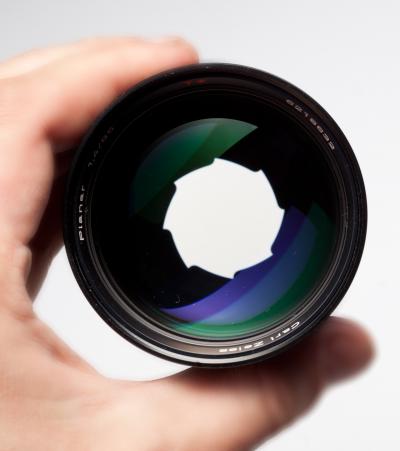
The frame allows you to perform automatic or manual adjustment of the parameters of the diaphragm. Diaphragm is an adjustable hole that controls the amount of light rays entering inside. It consists of moving metal petals, which, taking a different position, regulate the level of rays falling on the matrix. Petals are mobile both around the circle of the optical lens and beyond. This detail is necessary to work with depth of field when transferring space on the frame. The smaller the aperture, the clearer the picture on the frame.
Focusing mechanism and image stabilization
When photographing, another part of the lens plays a big role. With help focus ring manual focusing is performed. When the ring is rotated, it focuses on the front or on the back. The focus ring helps to work with a variable focal length (the more familiar name is “zoom”, “zooming in the image”, etc.) both in manual and automatic mode, of course, if the latter is supported by the model.
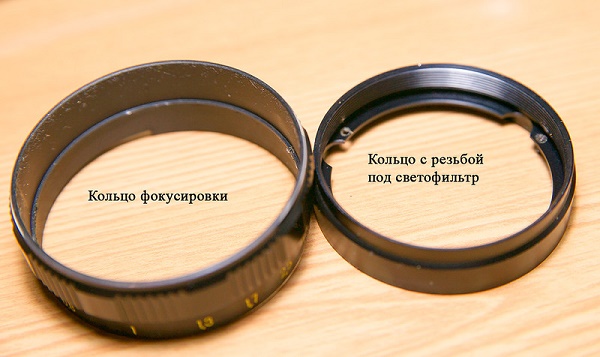
In models with autofocus function, the ring is rotated using a mechanical manipulator. If you press the shutter, it is automatically calibrated in the center.
Manufacturers of modern cameras use ultrasonic drives for focusing (USM), which are built directly into the lenses. With this device, extremely fast and smooth focusing is provided. Also known lens with screwdriver. The downside of this system is slower and noisy work. The screwdriver in the camera is a motor through which the rotation of individual parts occurs, due to which focusing occurs. It is located outside the case, on a metal ring for mounting the device.
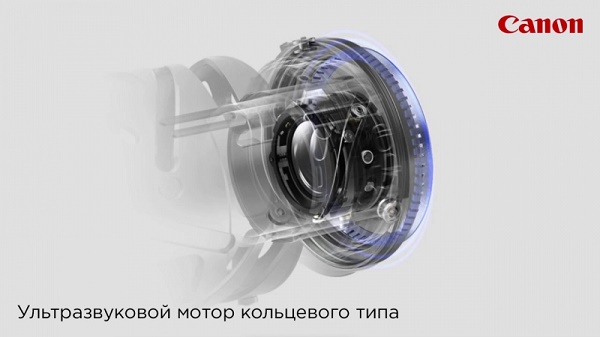
In addition to autofocus in the lens can be present and stabilization mechanismcompensating for inertia with long exposure. This allows you to get clear shots without the use of a tripod. Variable focus lenses are equipped with a zoom ring, which is used to change the focus distance. With these rings, you can significantly zoom in or out the object inside the frame.
Types of lenses and their application
For a SLR camera, there are various types of lenses.If the camera is equipped with a fixed lens, the frame will be built into the design of the device. But more popular models with removable lenses. Various filters can be attached to the lens itself, depending on the methods and location of the shooting. Lens sizes can also vary greatly.
To fix the lens on the body of the device, a bayonet is used - a special mount. Each manufacturer produces its own patterns, so there are no universal lenses, with the exception of a few “open” standards of the bayonet.
So, consider what lenses are.
Whale
Whale lenses are mostly preferred by beginners. It is an optics supplied complete with camera body. The viewing angles of whale optics are almost identical to those in humans, without taking into account peripheral vision. This fact makes whale optics quite popular, such devices are easy and convenient to use in everyday shooting, for staging simple shots. Sometimes a whale is called a standard or complete lens. This is a universal thing for a wide range of applications. The whale lens is notable for its low price, as well as the ability to take photos in almost any format: from a moving object to a portrait or micro-shot.The quality of the final image varies from low to fairly high.

Wide angle
Types of lenses for SLR cameras include a wide-angle format. These are optics with a wide range of visibility (from 60 degrees and more). With the help of such optics it is very convenient. shoot a group of people and take photos in cramped spaces. The background at the same time remains slightly blurred. The focal length can reach 28 mm. Such lenses cost a lot of money, but in most cases their purchase is justified. Used for wedding and interior shooting, as well as landscapes.
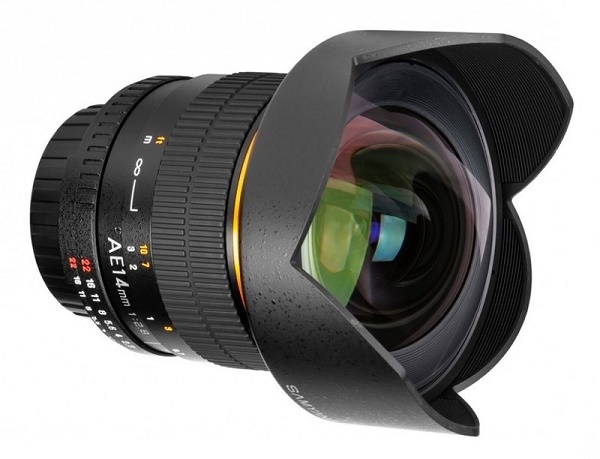

Fish eye
This is optics with faulty distortion. The angle of the visible field of this lens is as much as 180 degrees. The focus distance is from 4.5 to 15 mm.
Distortion in the environment of photographers is called distortion, making an arc from a straight line of the horizon, similar to a real fish eye.
Sometimes this lens is also called "fish". With the help of such optics it is convenient to do circular and diagonal photo. Using the "fisheye", often taken city shots, as well as photos of extreme sports.
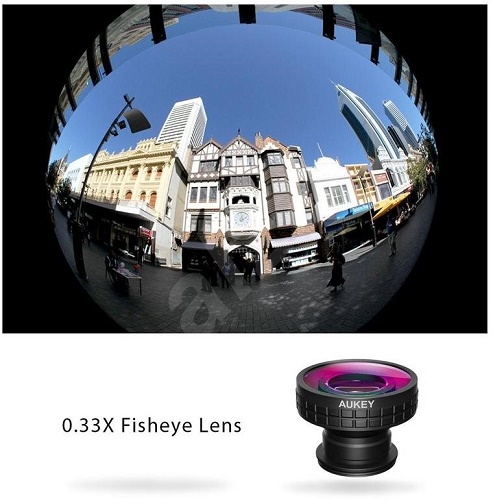
Macro lens
As the name implies, this is a lens designed for photofilming small objects. As a rule, such optics allows you to take close-ups from a short distance. Focus distance is from 50 to 180 mm. The maximum aperture value is f / 2/8. A feature of this optics is the ability to focus on small objects, as well as the high sharpness of the image and good color reproduction. Most often used in natural photography (insects, flowers, etc.).

Long focus
Optics with a long focus distance from 70 to 300 mm. Visibility ranges from 39 degrees. Such optics can be of two types: telephoto and telephoto lens. In connection with the blurring of boundaries, today both of these concepts are finally mixed up and become identical. Used for photographing moving objects and events: sports competitions, moments from the natural world.
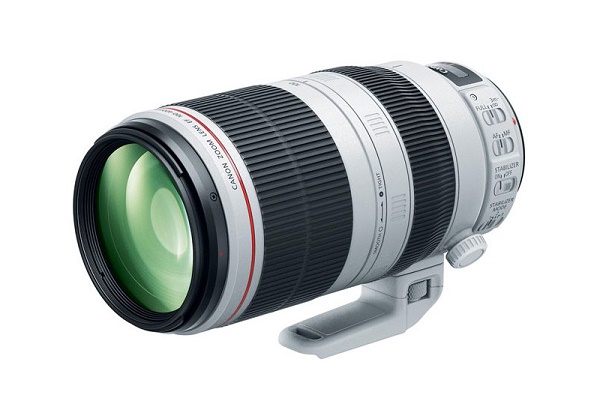
Canon Long Lens Lens
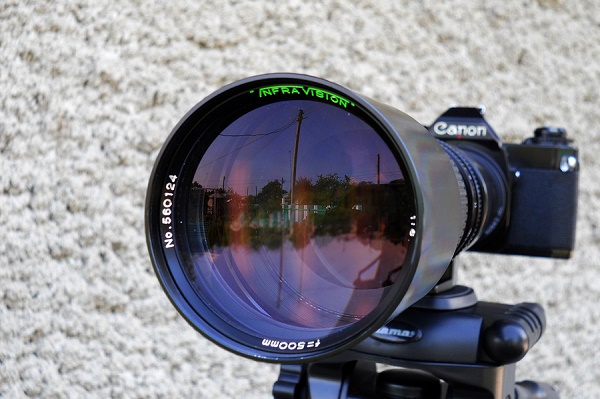
Canon Telephoto Lens
Portrait optics
Lens with a distance of focus, which during operation remains unchanged. Best suited for portraits. Possesses high luminosity rates. Portrait lens allows you to mask small skin defects.
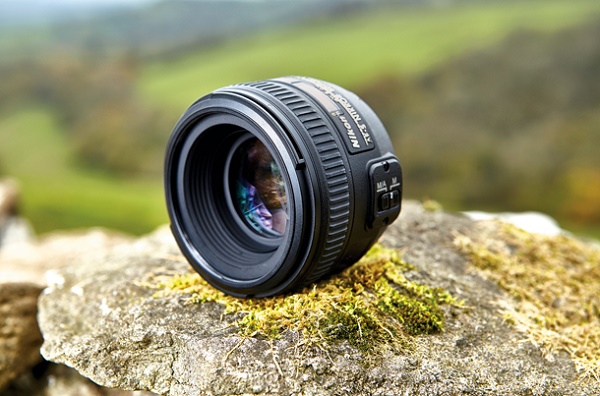
The main criteria for choosing a lens
You can choose a camera lens by several criteria.
- Focal length. One of the most important parameters when choosing optics. Unfortunately, it is rather difficult to recommend certain specific parameters in view of the fact that only the photographer himself can know the minimum focusing distance. The most effective lenses, as a rule, have a short focus distance. To measure the focal length, it is necessary to measure the distance between the focal plane and the subject.
- Aperture The most important criterion for those who plan to shoot in low visibility conditions and poor lighting. Optics with high luminosity rates are usually of very high quality. If possible, it would be better to purchase optics with the highest value of luminosity. It is important to remember that the constant value of the aperture for the lens is better, because luminosity values change with focus distance.
- Image stabilization. This parameter has a professional lens models. Devices with long-focus photography need stabilization the most.The best so far image stabilizer in almost any climatic conditions was and remains the most ordinary tripod. However, if the model has a built-in stabilization system, you should probably use it.
- Manufacturers. The main manufacturers of lenses are two companies - Canon and Nikon. In most cases, it makes sense to buy their products. Sony has products on the market, but it was the technology of the first two manufacturers that was noted by most professional photographers as the most convenient and reliable.
- Mount. Fastening lenses is an open, debatable issue among professionals. To date, no universal type of attachment has been developed, which would be adhered to by the main players in the photographic equipment market. Each manufacturer produces optics with a unique mount, designed only for its own equipment. With the exception of several lenses that claim to be universal, the technical side of the issue of attaching the lens to the body of the device is not worth it. By purchasing a certain body, the future owner already knows which firm he will have the lens.
How to perform a lens change
The first and very important point that must be observed is the cleanliness of the room in which the replacement takes place. It is desirable that the room had no air flow. The device is put down on the screen with a soft cloth to prevent scratches. Next, you need to prepare the lens, which is planned to be installed. It is desirable that he was at hand all this time. With the finger of the left hand we press on unlock button, after which you can unscrew and remove the lens. Unscrew the lens counterclockwise. It should be put aside.

The removed lens must be covered with a protective cover (cap) to prevent direct sunlight, better dust, and moisture.
Then we take a new lens in our hands and fix it in red or white (depending on the manufacturer) points. After the lens enters the corresponding grooves, it should be carefully screwed in a clockwise direction. When the thread is completely twisted, a distinctive click will be heard, indicating that the process is complete.


When carrying out the replacement of optics there may be various problems. If a lens jammed, then a few simple steps should be taken:
- check the instrument display for lens errors;
- recall whether the camera has received physical damage lately;
- ask for clarification from the user manual.
If the primary diagnosis did not help, it is necessary to slap his palm to the side. Light shots on the body sometimes help to resume the work of the jammed lens. As one of the options, you can try to clean the tube and connect the device through the cord to charge. Sometimes the problem may be hiding in the lack of battery power.
Still not extending the lens? It's possible make by hand. To do this, gently rotate the lens with your fingers, not in automatic mode. Sometimes you can slightly push or try to pull the optics. You can also put the device down with a lens and knock it on the palm, folded in the form of a handful. If there is a click, it means that the lenses have returned to their original position.Sometimes you can try forced autofocus, in some cases there is a chance to correct the images with such an error.
If none of the suggested recommendations helped, it would be best to take the camera to the service.
Self-adjusting lens
The alignment process is a sharp setting to improve optics performance. Calibration is carried out due to the correct exposure of all lenses. This allows you to make better pictures. The process is not simple, requiring experience, skill and perseverance, so it is recommended to produce it only if the user is confident in their own abilities.
The adjustment of the camera is made in the case of a factory defect, if the lens is “razboltan” increased backlashes and gaps, after mechanical damage to photographic equipment.
Many modern appliances boast self-diagnostic function "Live View". With the presence of this function it is much easier to establish whether the device needs adjustment or not. If the model is equipped with a “Live View”, then the following steps are necessary for the adjustment.
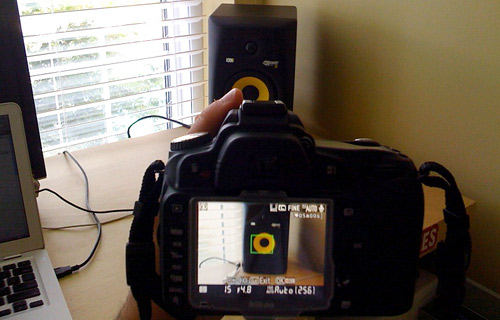
- Put the device on a tripod, turn on stabilization, if any.
- Using the "Live View", focusing on the target (target).
- The diaphragm must be open.
- Disabling the "Live View" function with the return of the device to the "One-Shot AF" mode with the focus set at the center point. The tripod and focus ring cannot be touched.
- You should press the AF button or the shutter release at half strength, watching the distance indicators on the lens itself and the focus ring. The latter must remain motionless. If nothing has moved, then adjustment is not required.
- If the distance scale or the ring did move, you need to fix exactly where. If the model has an autofocus adjustment, it is necessary to make corrections corresponding to the initial parameters.
Alignment at home without a “Live View” and autofocus adjustment is possible, but it requires deep knowledge and the presence of special devices: an optical bench with a collimator, a microscope.
Cleaning the lens at home
Cleaning the camera lens is one of the main rituals of caring for equipment that has to be done by almost every user. As a rule, the lens begins to need cleaning afteras it falls under the rain or after shooting in a dusty windy weather. The wider the circumference of the lens, the more likely it is that debris will accumulate on it.
In order to wipe the camera lens, you need a clean room and several appliances.
- First you need to purge with special pear (its cost does not exceed 100 rubles). The tip of the pear is brought to the lens as short as possible and the process itself is carried out. In some cases, especially after the ingress of dry dust, a conventional blow may be sufficient.
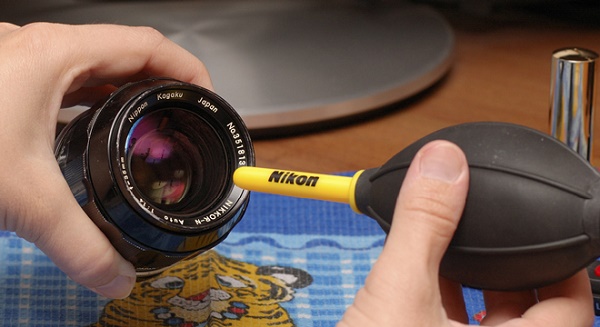
- If there is still debris on the lens, you can “sweep” it with special brush. This maneuver will not damage the sensitive lens and will allow to remove the most strongly adhering dust particles. Typically, this method allows you to clean the surface of the lens from unwanted dry debris. Against wet and oily stains, he is powerless. To combat divorce, rapidly evaporating solutions are needed, which are applied to a microfiber cloth. After application, the user does not have much time to clean the surface: such solutions very quickly "dry" (evaporate).
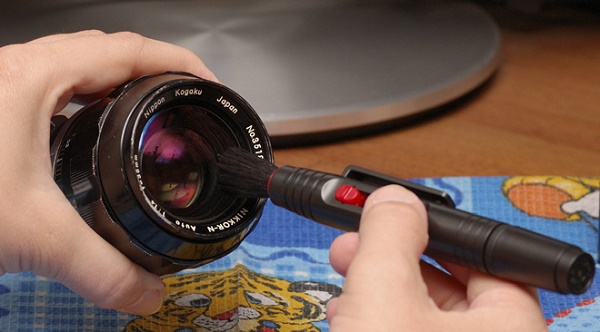
- If both of these methods did not help, you must use a special pencil or microfiber cloth. It is important to remember that you cannot use wadded disks - they can leave cotton particles on the lens, which will lead to additional contamination.
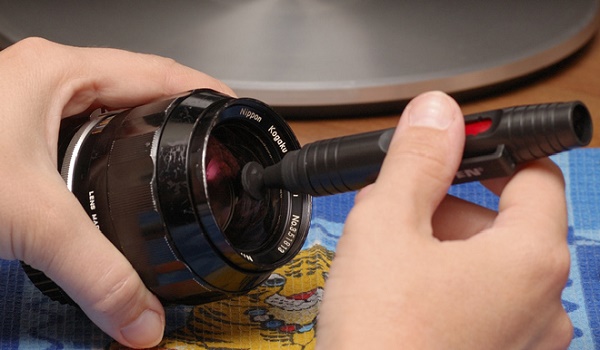
Sometimes instead of rags used shvabrochka. Shvabrochka is a plastic stick with a soft tip. With its help it is very convenient to clean the middle part of the lens.
The pencil for cleaning optics has two sides: graphite and softer. Graphite part necessary for cleaning up frozen debris. This device should be used carefully to avoid damaging sensitive optics. To clean problem areas (lens edges), it’s best to resort to soft side cleaning pencil.
In the case of using all three devices (a rag, a pencil and a shvabrochka) it is necessary to touch the surface of the lens very carefully, because the lens is very easy to damage. If you have doubts about your own abilities, it would be better to clean the lens in the service center.
Owning basic knowledge about the device and the operation of the lens, the user will always be able to independently diagnose and fix minor problems in case of their occurrence.In addition, information about the structure and types of lenses of the camera allows a more sober assessment of their prospects in photography, which is very important for novice photographers.

/rating_off.png)











